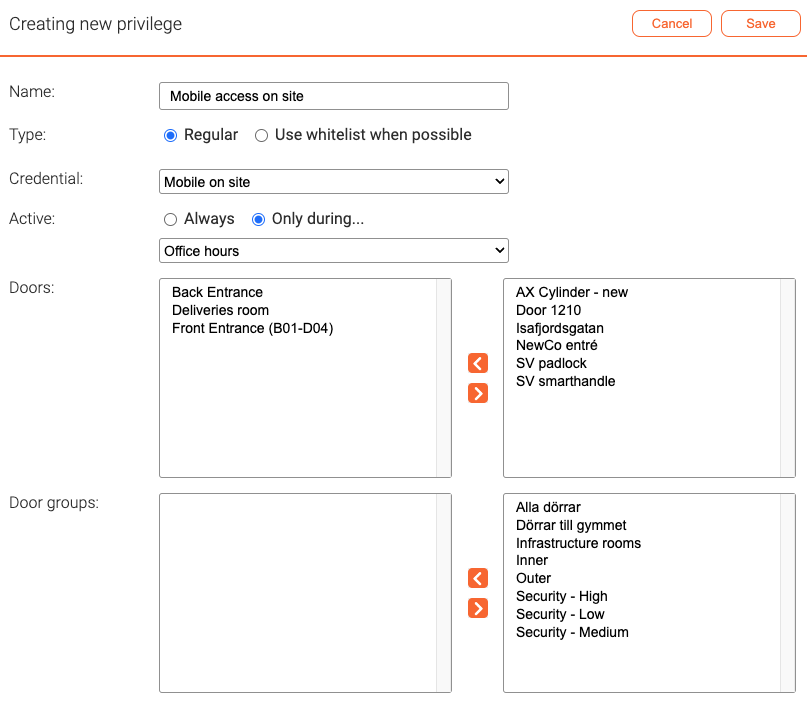Privileges: Difference between revisions
Telcredstaff (talk | contribs) No edit summary |
Telcredstaff (talk | contribs) No edit summary |
||
| Line 19: | Line 19: | ||
Start by giving the privilege a meaningful name. A good name indicates which door(s) the privilege opens and with which credential (e.g. card + PIN). |
Start by giving the privilege a meaningful name. A good name indicates which door(s) the privilege opens and with which credential (e.g. card + PIN). |
||
The next parameter is ''type'', and there are two options: "Regular" and "Use whitelist when possible". The whitelist option is only relevant for doors with locks from SimonsVoss. If the privilege has been defined with this type, the credential ID will be stored in the lock's own whitelist. In contrast, for privileges of type ''Regular'', it is the controller that makes the access control decision. |
The next parameter is ''type'', and there are two options: "Regular" and "Use whitelist when possible". The whitelist option is only relevant for doors with locks from [[SimonsVoss SmartIntego]]. If the privilege has been defined with this type, the credential ID will be stored in the lock's own whitelist. In contrast, for privileges of type ''Regular'', it is the controller that makes the access control decision. |
||
Select which credential should be used and optionally a schedule during which the privilege should be active. For privileges of type ''Use whitelist where possible'' the only credential type available is ''card only'' and it is not possible to specify a schedule. |
Select which credential should be used and optionally a schedule during which the privilege should be active. For privileges of type ''Use whitelist where possible'' the only credential type available is ''card only'' and it is not possible to specify a schedule. |
||
Revision as of 14:53, 22 September 2020
In Telcred Access Manager, privileges express access rights. You can think of a privilege as a key that opens one or more doors with a specified credential (e.g. card + PIN), optionally restricted to times defined by a schedule.
The possible credentials are:
- Card only
- Card + PIN
- PIN only
- Remote (The Telcred Entry app)
- API 1
- API 2
The purpose of API 1 and API 2 are to let an external system request access by supplying the door identity and a credential identifier that could represent e.g. a license plate, a face, or the customer's own smartphone app.
To create a new privilege, select Privileges in the main menu and click Add new.
Start by giving the privilege a meaningful name. A good name indicates which door(s) the privilege opens and with which credential (e.g. card + PIN).
The next parameter is type, and there are two options: "Regular" and "Use whitelist when possible". The whitelist option is only relevant for doors with locks from SimonsVoss SmartIntego. If the privilege has been defined with this type, the credential ID will be stored in the lock's own whitelist. In contrast, for privileges of type Regular, it is the controller that makes the access control decision.
Select which credential should be used and optionally a schedule during which the privilege should be active. For privileges of type Use whitelist where possible the only credential type available is card only and it is not possible to specify a schedule.
Finally, select the door(s) the privilege should be able to open by selecting them in the list to the right and moving them over to the left by clicking the left arrow. It is possible to specify the doors that the privilege should open either by including the individual doors or one or more door groups. It is perfectly fine to mix individual doors and door groups in the same privilege.
It is possible to share a privilege with another organization in the same system. Privilege sharing is explained in the section about delegation.
